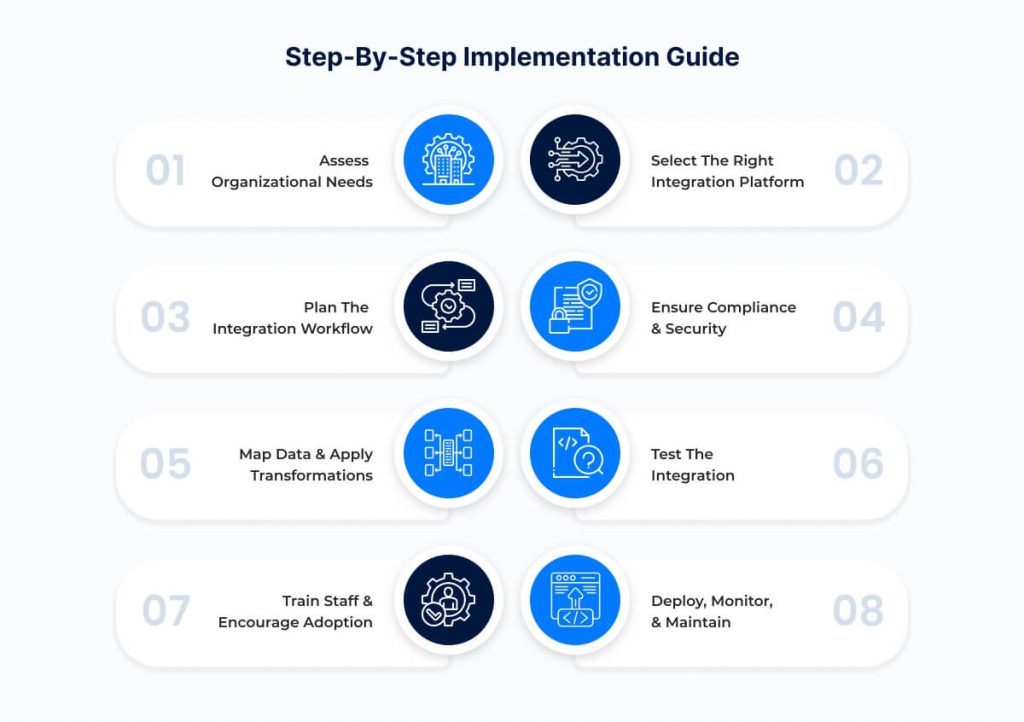Rising staff costs, limited physical space, workforce shortages, and the complexity of insurance reimbursement processes put pressure on healthcare providers to find effective and efficient solutions.
Among the key areas requiring attention is Revenue Cycle Management (RCM)—the process that manages billing, claims submission, and revenue collection from patients and payers.
Understanding the Role of AI in Revenue Cycle Management
Revenue Cycle Management involves every administrative and clinical function that captures revenue and ensures timely payments for healthcare services.
This includes patient scheduling, registration, claims coding, billing, claims submission, denial management, and collections.
In the U.S. healthcare system, with its complex payer structures and regulatory requirements, managing this cycle well is essential for financial sustainability.
AI has emerged as a powerful tool to improve many aspects of RCM.
According to recent studies, around 74% of hospitals and health systems in the U.S. use some form of automation in their revenue cycle, while nearly 46% report incorporating AI technologies as part of their workflows.
Medical practices, particularly specialty clinics, are increasingly automating significant portions of their RCM tasks, with 62% having automated up to 40% of these operations.
One of the key advantages of AI in this context is reducing human error.
Automated claim scrubbing uses AI algorithms that detect inconsistencies and errors in billing claims before submission.
This process increases what is called the “first-pass clean claims rate,” meaning claims get approved faster without needing additional corrections or multiple submissions.
Faster claim approvals mean quicker reimbursements and more stable cash flow, a benefit many U.S. practices seek amid uncertain payer policies and delayed payments.
Beyond accuracy, AI also supports predictive analytics to help healthcare administrators forecast revenue more reliably.
By analyzing historical billing data and payment trends, AI models can assess likely payment delays, predict denials, and suggest optimal staff assignments.
These insights help managers make informed decisions that improve revenue collection efficiency while reducing bottlenecks in the billing pipeline.
AI in Medical Billing and Coding
Billing and coding have traditionally been labor-intensive and error-prone parts of RCM.
Medical coders manually examine patient records, assign billing codes for services, and submit claims.
Mistakes in coding can lead to claim denials, delayed payments, and regulatory compliance issues.
AI-driven tools now analyze electronic health records (EHR) and medical documentation to recommend precise billing codes using natural language processing (NLP).
This reduces the burden on medical coders by automating routine coding tasks and highlighting cases that need more detailed review.
It also helps maintain compliance with ever-changing billing rules and payer requirements.
For example, some hospitals have demonstrated measurable improvement with these technologies.
Auburn Community Hospital reported a 40% increase in coder productivity and a 50% reduction in cases that were “discharged not final billed” after adopting AI tools for medical coding and claims processing.
This efficiency allows staff to focus on more complex cases and helps reduce reimbursement delays.
Despite these advances, AI is not intended to fully replace medical billing professionals.
Human expertise remains essential for validating AI suggestions, interpreting complex clinical data, and managing regulations.
AI acts as an enhancement tool that supports staff rather than eliminates their roles.
How Automation Enhances Workflow Efficiency in Healthcare Administration
Automation refers to using software and robotics to handle repetitive, manual tasks without direct human involvement.
In healthcare RCM, robotic process automation (RPA) can automatically verify patient insurance eligibility, complete prior authorizations, submit claims, track denials, and generate appeal letters.
This automation reduces the administrative burden often placed on medical offices, allowing staff to divert their time toward patient engagement and clinical responsibilities.
It also limits errors caused by data entry fatigue and the oversight of complex payer rules.
Banner Health, a U.S.-based health system, utilizes AI-powered bots to automate insurance coverage discovery and denial appeals.
They also employ predictive models that assess which claims should be written off, further improving revenue collection by reducing unnecessary follow-up work.
Similarly, a Fresno-based Community Health Care Network in California uses AI tools to pre-screen claims, which resulted in a 22% reduction in prior-authorization denials and an 18% decrease in denials for services not covered by insurance plans.
This system also saved 30 to 35 hours per week by automating routine denial follow-ups without increasing staffing levels.
In revenue cycle operations, automation includes AI-driven notifications for clinical documentation improvement (CDI), which alert billing teams when patient records require more information to support proper coding.
This collaborative approach between clinical staff and billing specialists further reduces claim denials and speeds reimbursement.
Improving Patient Financial Experience with AI
AI and automation technologies are also being used to help patients directly by creating more transparent, accurate, and personalized billing experiences.
Tools powered by AI analyze patient payment history and financial status to offer customized payment arrangements or reminders.
This helps improve collections and reduce patient frustration.
For instance, predictive analytics can forecast patient no-show rates for appointments and suggest scheduling strategies that help optimize throughput and reduce revenue loss.
Moreover, AI-driven chatbots can answer patient billing questions instantly, reducing call center volumes and improving satisfaction.
Medical practice administrators and IT managers in the U.S. medical system recognize that a patient-centered, clear approach to billing supported by technology is important for maintaining trust and minimizing bad debt.
Advanced Data Integration and Real-Time Analytics Supporting RCM and Patient Care
Integrated data solutions bring together information from electronic medical records (EMRs), patient management systems, payer databases, and financial platforms.
These systems have a big impact on healthcare workflows.
Providers like Striim offer SaaS platforms that support real-time data streaming and integration optimized for AI applications.
These systems enable healthcare organizations to access current data quickly, reduce billing errors, and minimize revenue leakage.
For example, real-time data analytics help with immediate verification of patient eligibility, automatic updates on payer policy changes, and active monitoring of revenue cycle metrics.
Real-time insights also help with workforce optimization, which is important in U.S. healthcare settings facing staff shortages.
By combining data across hospital systems, AI tools help managers allocate resources and schedule staff well, especially during patient surges.
Also, integrated platforms improve care by providing clinicians with up-to-date patient information, reducing repeated tests, and speeding treatment decisions.
These improvements in care coordination support the financial gains made through automated billing and claims processing.
AI and Workflow Automation: Transforming Front Office and Call Center Operations
Front-office tasks, such as answering patient phone calls, scheduling appointments, and handling billing questions, are important but take up a lot of time in medical practices.
Simbo AI, a company that focuses on AI-based front-office phone automation and answering services, shows how these tasks can be handled.
Simbo AI’s intelligent phone systems use advanced conversational AI and natural language processing to answer calls, schedule appointments, provide billing information, and direct patients to the right departments.
This technology reduces wait times, improves patient access to care, and lowers the workload on front desk staff.
Studies nationwide show that healthcare call centers improve productivity by 15% to 30% after adding AI-powered virtual assistants.
Automation helps handle large call numbers well, letting practices deal with common questions without needing more staff.
AI-driven phone automation can connect with existing EHR and practice management systems to verify eligibility automatically, confirm appointments, and even help with payment reminders.
This smoother workflow leads to better patient engagement and cuts down on administrative stress, supporting ongoing improvements in RCM.
Addressing Challenges and Future Directions in AI Adoption for Healthcare Practices
While AI and automation bring many benefits, some challenges remain for wider use, especially among smaller and specialty medical offices in the U.S.
High costs, technology difficulty, and staff training needs can make it hard for some offices to use advanced systems.
Experts suggest working with outsourced revenue cycle management providers who offer AI tools and automation without big upfront costs.
This allows practices to gain better efficiency, stronger cash flow, and improved patient care services.
Also, AI tools need ongoing oversight to avoid problems like data privacy issues, algorithm biases, and mistakes.
Human review is still important to ensure rules like HIPAA are followed and to keep patient billing fair.
Going forward, AI is expected to do more than handle simple tasks like prior authorizations and appeal letters.
It will take on more complex jobs, such as managing the entire revenue cycle and advanced financial forecasting.
Integration with blockchain and better real-time patient tools will also improve healthcare money management and operations.
Implications for Medical Practice Administrators and IT Managers in the United States
Medical practice administrators and IT managers in the United States have key roles in choosing and using AI and automation technologies.
They must balance money limits, staff skills, current systems, and patient needs when making decisions.
Key factors include:
- Investment in staff training and change management to help with smooth use of AI tools.
- Integration readiness with current electronic health record systems and billing platforms to avoid workflow problems.
- Vendor selection focusing on companies offering solutions that fit both small and bigger practices, like Simbo AI’s front-office automation services.
- Data security and compliance plans to meet federal and state rules and protect patient information.
- Monitoring performance using revenue cycle key performance indicators (KPIs) like days in accounts receivable, denial rates, and first-pass claims approval rates to check return on investment and improvements.
By carefully adding AI and automation, U.S. medical practices can improve their financial health and increase patient satisfaction at the same time.
As healthcare payment methods change, using technology in revenue cycle management will be important to keep good patient care.
Frequently Asked Questions
What role does AI play in revenue cycle management (RCM)?
AI enhances RCM by automating claims processing, reducing manual data entry, and improving accuracy in claims submission. It streamlines workflows, predicts potential denials, and optimizes financial planning.
What are the benefits of AI-enhanced claim scrubbing?
AI-enhanced claim scrubbing increases first-pass clean claims rates by identifying errors before submission. This ensures adherence to regulatory and payer-specific rules, enhancing efficiency and accuracy in the RCM process.
How does predictive analytics improve cash flow management?
Predictive analytics forecasts revenue based on historical data, optimizes staff allocation, and anticipates patient payment patterns, leading to improved cash flow management and financial planning.
What are the advantages of automation in RCM?
Automation reduces administrative workload, minimizes human errors, and streamlines repetitive tasks such as claims submission and eligibility checks, thereby enhancing the overall efficiency of the RCM process.
How can outsourcing RCM benefit specialty practices?
Outsourcing RCM provides access to advanced technology and AI tools that may be cost-prohibitive for individual practices, allowing them to scale efficiently and improve patient care.
What impact does AI have on staff workload?
AI can significantly reduce the administrative burden on clinical staff, allowing them to focus on value-added activities and patient care by automating routine tasks.
Why is automation crucial for a practice’s financial success?
Automation can lead to quicker reimbursements and cash flow stability by increasing clean claims rates, directly impacting a practice’s financial health as indicated by studies from McKinsey & Company.
How does machine learning enhance decision-making in RCM?
Machine learning analyzes large data sets to identify patterns, enabling improved decision-making regarding claim approvals and denials, thus supporting better revenue management strategies.
What challenges do medical practices face in adopting AI for RCM?
Many medical practices are slower to adopt AI due to high costs and complexity. However, leveraging partnerships with RCM providers can make these technologies more accessible.
What transformation is occurring in the RCM landscape due to AI?
AI, alongside automation and machine learning, is transforming RCM by making processes more efficient, accurate, and cost-effective, ultimately enhancing patient care and cash flow management.
The post The Future of Healthcare: Leveraging AI and Advanced Technologies for Improved Revenue Cycle Management and Patient Care first appeared on Simbo AI – Blogs.






